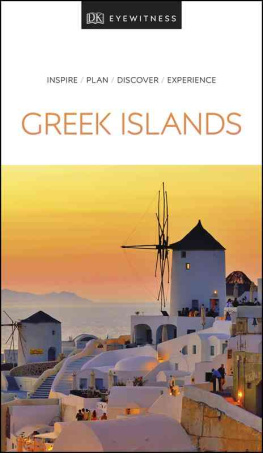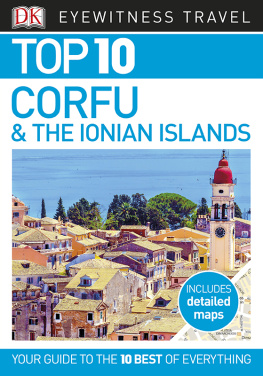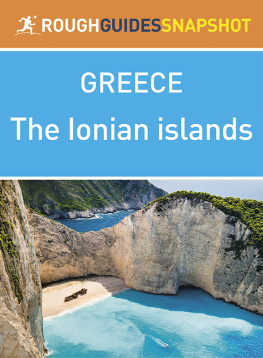Title Page
THE IONIAN ISLANDS AND EPIRUS
A Cultural History
by
Jim Potts
Publisher Information
First published in 2010 by
Signal Books Limited
36 Minster Road
Oxford OX4 1LY
www.signalbooks.co.uk
This digital edition converted and distributed in 2013 by
Andrews UK Limited
www.andrewsuk.com
Jim Potts, 2010, 2013
The right of Jim Potts to be identied as the author of this work has been asserted by him in accordance with the Copyright, Design and Patents Act, 1988.
All rights reserved. The whole of this work, including all text and illustrations, is protected by copyright. No parts of this work may be loaded, stored, manipulated, reproduced or transmitted in any form or by any means, electronic or mechanical, including photocopying and recording, or by any information, storage and retrieval system without prior written permission from the publisher, on behalf of the copyright owner.
Cover Design: Devdan Sen
Cover images: Maytree/dreamstime.com; Netfalls/shutterstock.com; Netfalls/dreamstime.com (aps).
Illustrations: (c) Jim Potts pp. 4, 12, 29, 78, 83, 103, 116, 159, 165, 166, 171, 183, 192, 234; dreamstime.com pp. 1, 26, 41, 55, 177; istockphoto.com pp. i, 43, 91, 125, 128, 139, 144, 207, 210;
Preface & Acknowledgements
I rst came to Corfu in the summer of 1967, as I had been oered a teaching position on the island. In December 1967 I received a letter from Sir Maurice Bowra, Warden of Wadham College Oxford, my old college, saying Nobody could blame you for teaching at a school in Greece. What I rather dislike is people going there for a holiday and saying how splendid it all is (29 December 1967). His comments had a bigger inuence on me than I realized in that rst year of the Military Dictatorship. I lived and worked in Northern Greece for ve years, from 1980 to 1985. Ive been resident in Greece again (in Corfu and Zagori) since the end of 2004. When not living in the country, Ive been coming almost every year since 1967, so Ive seen many changes. My wife is a Corot and a true Ionian Islander. Her mother came from Paxos, her father from Zakynthos, but she was born in Corfu. She has written two inspiring and challenging books about Corfu, one in English, one in Greek.
There are in fact 32 Ionian Islands, large and small, of which 13 are inhabited: Othoni, Erikousa, Mathraki, Corfu, Paxos, Antipaxos, Lefkas, Meganisi, Kastos, Kalamos, Ithaca, Kefalonia and Zakynthos. Kythira, although once considered part of the Seven Islands or Eptanisos, is no longer treated as one of the Ionian Islands administratively or geographically.
This book is aimed primarily at a British, North American and Australian readership. I hope it will oer visitors, English-speaking residents and interested tourists from other countries new insights into many aspects of the cultural histories of the Ionian Islands and Epirus. I have tried to adopt an international approach.
The combined populations of the regions of the Ionian Islands and Epirus may only represent just over 5% of the total population of Greece (NSSG, 2008 gures: 580,358 inhabitants out of 11,213,785) but what an impact that 5% has had!
The publication of this book nearly coincides with the 200 th anniversary of Byrons visit to Epirus (Prevesa, Nicopolis, Ioannina and Zitsa, 29 September3 November 1809) and of the British capture of Zakynthos, Kefalonia, Ithaca and Kythira, which occurred between 2 and 9 October 1809. To adapt the words of Horace, the captive Ionian Islands eventually made their uncouth victors captive. The Ionian Islands became part of the Greek State in 1864, Ioannina and most of Epirus in 1913 (the Arta district, with hessaly, had been ceded to Greece in 1881, as a result of the decision of the Great Powers and of the Treaty of Berlin).
***
I wish to express my special thanks to the following, amongst many others, who have provided information, insights and inspiration: Maria StraniPotts, Dr. Kostas Kardamis, John Gill, Brenda Stones, hemis and June Marinos, Demetrius Toteras, Komninos Zervos, Frixos Tziovas, Yannis Pieris, Alexandros Papadatos, Nikos Grigoropoulos, Lena Koronaki, Stephanos Rizikaris, Ian Chessell, Peter Prineas, Paul Cummings, Zoe Kominatos, Raul Scacchi, Gioia Maestro, Pinelopi Mitsi, Demetrios Dallas, the Sta of the Mitchell Library, Sydney, and the Sta of the British Library, London. I also wish to thank all those writers from whose works I have quoted.
A note on the spelling of names
Readers will come across many variant spellings and some inconsistencies in this book. When giving direct quotations, I have retained the spellings used by the writers cited. I have not been systematic in my own usage, preferring Kefalonia to Cephal(l)onia, Ithaca to Ithaki, Cavafy to Kavafy, Capodistrias to Kapodistrias, Nicopolis to Nikopolis, but Komnena to Comnena, Corfu to Kerkyra, Kythira to Kythera or Cyther(e)a, Lefkas to Levkas, Lefkada or Leucadia,Vido to Vidho, Ioannina to Yannina, Janina or Giannena, Prevesa to Preveza, Metsovo to Metzovo, Pasha to Pacha, Epirus to Ipirus or Epiros, Pindus to Pindos, but Dramisios to Dhramisius, Corot to Corote, Suliot to Souliote, Epirot to Epirote, Chimariot to Chimeriote (but Gardikiote rather than Gardikiot, Parghiote or Parginote rather than Parghiot), Chams to Tsams, Hormovo to Khormova(o), Nekromanteion to Necromanteion, Frosini to Phrosini or Phrosyne, kleft to klepht, Palaiokastritsa to Paleokastritza, Seras to Seraphis, Aghios to Agios or Ayios.
At times I use alternative or older forms of names for islands (Zante as well as Zakynthos, but not Zacynthus, Cerigo as well as Kythira, Santa Mavra/Maura, as well as Lefkas, Leucas and Lefkada, Corcyra as well as Corfu). Zakynthians are also referred to, interchangeably, as Zakynthiots and Zantiots. It is my hope that the patient reader will not nd the many transliteration permutations too confusing or irritating!
Dedication
This book is dedicated to Jack, Ella and ho, in the hope that it will help them to appreciate an important part of their cultural inheritance.
Introduction
For 42 years I have been trying to develop a deeper understanding of Greek culture. Almost every day I have discovered something new or astonishing.
Greece remains a source of endless fascination. What makes a Western Greek, or an Ionian Islander, dierent from a Greek from the mainland? What distinguishes a Corot from a Kefalonian? With so many Epirots living in Corfu (including the descendants of those who had to ee from Parga and Suli in the nineteenth century), with so many Kythirans living in Australia, it is not even clear what we mean by a Corot, a Kythiran or an Epirot. The sea-channel between Corfu and the coast of Epirus is not wide. Lefkas is attached to the mainland. Culturally the islands could have been worlds apart.
To the Corot critic and poet Erotokritos Moraitis (in Solomos), the identity of the gigenis Dhitikos Ellinas (native Western Greek) is self-evident and signicant, an identity largely unrecognized in Modern Greece, which has given much greater emphasis to the Anatolian, Oriental, cultural inuences. For the Zakynthos-born poet Dionysios Solomos (1798-1857), the National Poet and author of the anthem Hymn to Liberty, as for many other educated Ionians, Italian was as much a mother-tongue as Greek. Bilingualism, education and music were just some of the elements that seemed to separate the islanders from Turkey-in-Europe, and Greek Epirus, until recent times. For the Ionian Islands belonged, culturally, to Western Europe. Even if Epirus seemed like a foreign country to a Corot like Moraitis when he rst visited Igoumenitsa, who can deny that Ioannina was also a great centre of education and learning, and that the people of the Zagori villages in Epirus, for instance, enjoyed a high standard of living and a great deal of independence, and that the menfolk, who usually went o to make their living in other parts of Europe or even further aeld, brought back with them rened architectural tastes, and that many became enlightened and generous benefactors of their communities?
Next page


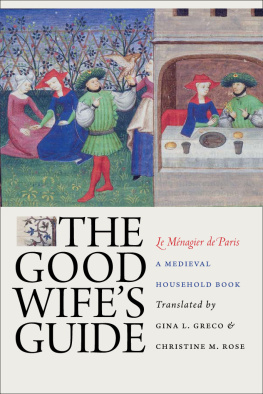


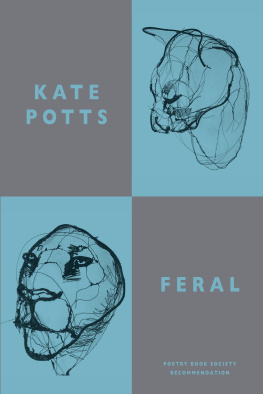
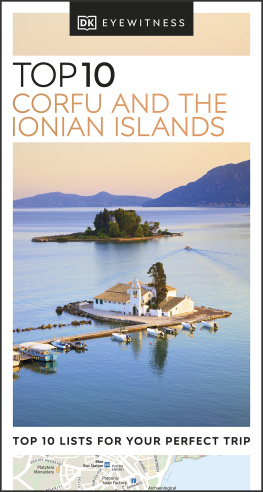

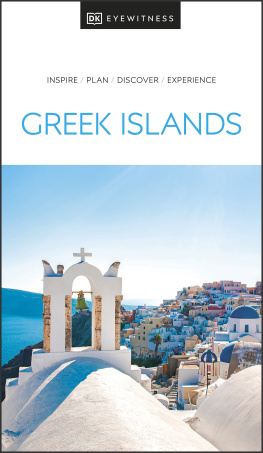
![Sherry Marker - Frommers Greek Islands [2010]](/uploads/posts/book/235532/thumbs/sherry-marker-frommer-s-greek-islands-2010.jpg)
![Greek islands [2018]](/uploads/posts/book/209249/thumbs/greek-islands-2018.jpg)

